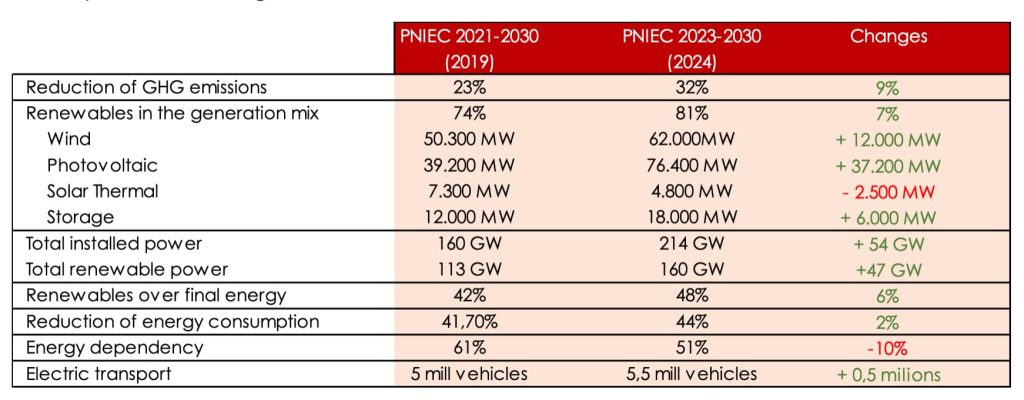
This is how the Magnus Commodities BLOG started in 2019 “… Last Friday, February 22, 2019, the Council of Ministers approved the submission to the European Commission of the draft of the National Integrated Energy and Climate Plan 2021-2030 (PNIEC)…” (https://magnuscmd.com/the-roadmap-of-the-energy-transition-2021-2030/ )to talk about what was to be the government’s roadmap for the 2030 energy transition and whose origin lay in the Paris agreement of 2015. Five years later, the European Commission looks set to endorse the proposal for the revision of the PINIEC 2023-2030
The PNIEC and its Importance
The Plan emerged as a fundamental pillar in the country’s strategy to address the environmental and energy challenges of the 21st century. This ambitious plan, designed for the period 2021-2030, focuses on reducing greenhouse gas emissions and transitioning to a more sustainable energy matrix.
The document now adopted considerably increases the already ambitious targets and opens the way to new challenges. In the attached table we can see the main differences:

These objectives also include 19 gigawatts (GW) of self-consumption facilities, 11 gigawatts of electrolysers to produce green hydrogen and 22 gigawatts of storage, among other objectives.The PNIEC strategy covers a variety of areas, from the electrification of transport to the rehabilitation of buildings to improve energy efficiency. Mobilising investment and promoting research and innovation are key elements for the success of these strategies. Likewise, the creation of green jobs and the promotion of a just transition for communities affected by transformation are essential aspects of the plan.
Challenges and Future of the PNIEC
Although the PNIEC presents a promising horizon, it is not without its challenges. The financing of proposed measures, resistance to change in certain sectors, and the need for effective coordination between different levels of government and private actors are challenges to consider.One of the great unknowns for the achievement of the ambitious objectives of the plan is to adapt the current plan for the development of the electrification infrastructure for the coming years. How will the increase in the penetration of renewables to 81% of generation be accommodated?At the same time, the Ministry for the Ecological Transition and the Demographic Challenge (MITECO) has initiated the procedure to design the Electricity Planning with a 2025-2030 horizon with the publication of the ministerial order in the Official State Gazette that calls on interested parties to submit their proposals to Red Eléctrica (OS).
In conclusion, its effective implementation will depend on collaboration between government, civil society, and the private sector. The path to a greener Spain is mapped out, and the successful implementation of the PNIEC should not only contribute to the global fight against climate change, but would also benefit future generations and consolidate Spain’s position as a pioneer in the transition to a more sustainable world.
How does the PNIEC affect my company?
How Spain’s National Energy and Climate Plan (PNIEC) affects a company can vary depending on the sector in which it operates and its reliance on current energy sources and practices. However, there are key areas where the PNIEC could influence your business:
- Regulatory Compliance: (Environmental Regulations) The plan sets goals and measures to reduce greenhouse gas emissions and promote the use of renewable energy. Depending on your company’s industry, new environmental regulations may be introduced that affect current operations.
- Energy Efficiency: (Efficiency Requirements) Seeks to improve energy efficiency in different sectors. Your business could face stricter requirements in terms of energy consumption, which could mean the need to implement measures to reduce consumption and increase operational efficiency.
- Clean Technology Investments: (Investment Opportunities) The transition to cleaner and more sustainable energy sources could create opportunities to invest in green technologies. If your company operates in sectors related to renewable energy, energy efficiency, or clean technologies, you could benefit from the government’s push into these areas.
- Competitiveness and Reputation: (Market Differentiation) While becoming less and less differentiating, adopting sustainable business practices can improve your company’s reputation. Consumers and customers increasingly value companies committed to sustainability and environmental responsibility.
- Operational and financial costs: Depending on your company’s current structure, implementing measures to comply with the requirements of the PNIEC could involve changes in operating costs. However, in the long term, energy efficiency and the adoption of renewable energy sources could help reduce costs and improve financial sustainability.
- Collaboration with government and other actors: (Participation in government programs) The NECP could include incentives for companies that actively contribute to energy and climate goals. It explores the possibility of collaborating with the government and other actors to access support and funding programs.
- Adapting to Supply Chain Changes: (Supplier Assessment) As regulations change, you may need to evaluate and adapt your supply chain. Selecting suppliers committed to sustainable practices could become more crucial.
In summary, the impact of the PNIEC on your business will depend on a number of factors. It is essential to conduct a detailed analysis of how the objectives and measures of the plan align with the specific nature and operations of your business, so that you can anticipate and appropriately address changes that may arise. At Magnus we are very committed to this transition process, and we accompany our clients to its compliance.
Alejandro De Roca | Markets & Regulation Director
If you found it interesting, please share it!
Recent Articles



































